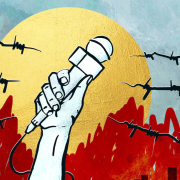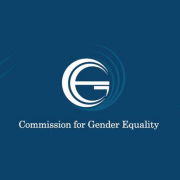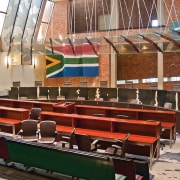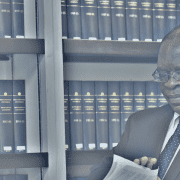|
Getting your Trinity Audio player ready...
|
Twenty-five years ago, then president Nelson Mandela put his signature to the final text of South Africa’s Constitution, and it became law. The date was 10 December 1996; the place was Sharpeville, in Vereeniging, south of Johannesburg.
This location is historically significant to all South Africans as, just 36 years before, police had opened fire, using live ammunition, on a crowd protesting against the degrading and dehumanising pass laws of the time, and which had gathered outside Sharpeville’s police station. The infamous Sharpeville massacre left 69 people dead and, according to the official inquest, 180 people seriously wounded.
“Out of the many Sharpevilles which haunt our history was born the unshakeable determination that respect for human life, liberty and well-being must be enshrined as rights beyond the power of any force to diminish,” said Mandela on the day of signing.
Those rights, Mandela added, were the guiding light during the negotiations in which the nation “turned its back on conflict and division. They were affirmed by our people in all their millions in our country’s first democratic elections. Now, at last, they are embodied in the highest law of our rainbow nation.”
The country owes this to many who suffered and sacrificed for justice and freedom, Mandela added.
“Here, at Sharpeville, in Vereeniging, both powerful symbols of past relationships between South Africans, we are making a break with the past. A break with the pain, a break with betrayal. We are starting a new chapter,” said Cyril Ramaphosa, then chairperson of the Constitutional Assembly and currently South Africa’s president, at the time.
The Constitution was published in the Government Gazette on 18 December, but only came into effect on 3 February 1997.
South Africa had been governed by an interim constitution since 27 April 1994, when the interim document became law. The next version went back and forth several times between the Constitutional Assembly and the Constitutional Court. The latter institution received the final version on 4 December 1996, approved it, and the rest, as they say, is history.
Since its adoption, the Constitution has been amended 17 times; an 18th is currently in progress, with the aim of amending section 25 so as to provide for land expropriation without compensation, if that expropriation is for land reform.
In a motion in the National Assembly on 7 December 2021, the 18th amendment bill was rejected by the House.
Section 74 of the Constitution provides that an amendment bill can only be passed if at least two-thirds of the members of the National Assembly (that is, at least 267 of the 400 members) vote in favour of it. If the amendment affects provincial powers or boundaries, or if it amends the Bill of Rights, at least six of the nine provinces in the National Council of Provinces must also vote for it. To amend section 1 of the Constitution, which establishes the existence of South Africa as a sovereign, democratic state, and lays out the country’s founding values, would require the support of three-quarters of the members of the National Assembly.
Structure of SA’s Constitution
The constitution consists of a preamble, 14 chapters containing 244 sections, and eight schedules.
Chapter 1: Founding provisions
The most profound values and foundational provisions of the Constitution are set out in chapter 1. This chapter enshrines key values such as dignity, non-racialism, non-sexism and constitutional supremacy. It defines the country’s symbols such as the flag and national anthem, and specifies its official languages and principles that should inform the government’s language policy.
Chapter 2: Bill of rights
Chapter 2 lays out the civil, political, economic, social and cultural human rights of the people of South Africa. Most of these rights apply to anyone in the country, with the exception of the right to vote, the right to work and the right to enter the country, which apply only to citizens. They also apply to juristic persons to the extent that they are applicable, taking into account the nature of the right. These are the rights:
- Section 9: everyone is equal before the law and has right to equal protection and the benefit of the law. Prohibited grounds of discrimination include race, gender, sex, pregnancy, marital status, ethnic or social origin, colour, sexual orientation, age, disability, religion, conscience, belief, culture, language and birth.
- Section 10: the right to human dignity.
- Section 11: the right to life
- Section 12: the right to freedom and security of the person, including protection against arbitrary detention and detention without trial, the right to be protected against violence, freedom from torture, freedom from cruel, inhuman or degrading treatment, the right to bodily integrity, and reproductive rights.
- Section 13: freedom from slavery, servitude or forced labour.
- Section 14: the right to privacy, including protection against search and seizure, and the privacy of correspondence.
- Section 15: freedom of thought and freedom of religion.
- Section 16: freedom of speech and expression, including freedom of the press and academic freedom. Explicitly excluded are propaganda for war, incitement to violence and advocacy of hatred based on race, ethnicity, gender or religion.
- Section 17: freedom of assembly and the right to protest.
- Section 18: freedom of association.
- Section 19: the right to vote and universal adult suffrage; the right to stand for public office; the right to free, fair and regular elections; and the right to form, join and campaign for a political party.
- Section 20: no citizen may be deprived of citizenship.
- Section 21: freedom of movement, including the right to leave South Africa, the right of citizens to a passport and the right to enter South Africa.
- Section 22: the right to choose a trade, occupation or profession, although these may be regulated by law.
- Section 23: labour rights, including the right to unionise and the right to strike.
- Section 24: the right to a healthy environment protected.
- Section 25: the right to property, limited in that property may only be expropriated under a law of general application (not arbitrarily), for a public purpose and with the payment of compensation.
- Section 26: the right to housing, including the right to due process with regard to court-ordered eviction and demolition.
- Section 27: the rights to food, water, health care and social assistance, which the state must progressively realise within the limits of its resources.
- Section 28: children’s rights, including the right to a name and nationality, the right to family or parental care, the right to a basic standard of living, the right to be protected from maltreatment and abuse, the protection from inappropriate child labour, the right not to be detained except as a last resort, the paramountcy of the best interests of the child and the right to an independent lawyer in court cases involving the child, and the prohibition of the military use of children.
- Section 29: the right to education, including a universal right to basic education.
- Section 30: the right to use the language of one’s choice and to participate in the cultural life of one’s choice.
- Section 31: the right of cultural, religious or linguistic communities to enjoy their culture, practise their religion and use their language.
- Section 32: the right of access to information, including all information held by the government.
- Section 33: the right to justice in administrative action by the government.
- Section 34: the right of access to the courts.
- Section 35: the rights of arrested, detained and accused people, including the right to silence, protection against self-incrimination, the right to counsel and legal aid, the right to a fair trial, the presumption of innocence and the prohibition of double jeopardy and ex post facto crimes.
Section 36 allows the rights listed to be limited only by laws of general application, and only to the extent that the restriction is reasonable and justifiable in “an open and democratic society based on human dignity, equality and freedom.”
Section 37 allows certain rights to be limited during a state of emergency but places strict procedural limits on the declaration of states of emergency and provides for the rights of people detained as a result.
Chapter 3: Co-operative government
This chapter lays down the principles of co-operative government. It states that there is one central government that is divided into three spheres: national, provincial and local. Each sphere is autonomous, and all three spheres have to work together.
Chapter 4: Parliament
Chapter 4 defines the structure of Parliament, the legislative branch of the national government. Parliament consists of two houses, the National Assembly (the lower house), which is directly elected by the people, and the National Council of Provinces (the upper house), which is elected by the provincial legislatures.
Chapter 5: The president and national executive
Chapter 5 defines the structure of the national executive and the powers of the president. The National Executive consists of the president, the deputy president and ministers. The president cannot exercise any power that is not conferred by law and the exercise of that power must be rational, which has been interpreted by legal experts to mean that the president must act rationally when appointing or dismissing members of Cabinet.
Chapter 6: Provinces
Chapter 6 establishes the nine provinces of South Africa and sets out the makeup of provincial legislatures and executives and their powers. It also sets out the areas over which both the national government and the provincial government may make laws and states what happens if these laws contradict each other. This chapter also deals with the drafting of provincial constitutions.
Chapter 7: Local government
This chapter describes the status, powers, functions and composition of local government/municipalities. It explains the makeup of local government, its powers and functions. Local governments make decisions and laws for their municipal areas. Municipal councils carry out the executive and legislative functions of local government. The chapter requires municipal elections to be held every five years.
Chapter 8: Courts and administration of justice
Chapter 8 of the Constitution defines the structure and power of the judiciary, with section 165 of the Constitution conferring the judicial authority to the courts. Judicial authority empowers the courts to interpret and apply the law when considering legal cases before them.
Chapter 9: State institutions supporting constitutional democracy
Chapter 9 establishes a number of state institutions tasked with supporting our constitutional democracy. The task of these institutions is to promote and protect those rights within the Bill of Rights which fall within their particular area. These bodies are the Public Protector, the South African Human Rights Commission, the Commission for the Promotion and Protection of the Rights of Cultural, Religious and Linguistic Communities, the Commission for Gender Equality, the Auditor-General, the Independent Electoral Commission and the Independent Communications Authority.
Chapter 10: Public administration
This chapter sets out the principles which govern the public administration and people who are employed by the state. It also sets out the principles and framework within which the public administration must operate in order to deliver government services to the people, and establishes the Public Service Commission as an oversight body.
Chapter 11: Security services
Chapter 11 establishes structures for civilian control of the defence force, the police service and the intelligence services. It states how the police, army and intelligence services must work in order to secure the state. This chapter also requires security services to operate in a manner that does not violate important constitutional values and principles.
Chapter 12: Traditional leaders
This chapter deals with traditional leaders and their role in our democracy, and recognises the role and status of traditional leadership according to customary law. It allows for traditional authorities to function within the framework of the country’s legal system.
Chapter 13: Finance
This chapter gives emphasis to the need for transparency, accountability and the effective financial management of the economy. It establishes a national revenue fund, provincial revenue funds, the Financial and Fiscal Commission, and the Reserve Bank. It provides for an equitable distribution of national revenue to the provinces and municipalities, and grants provincial and local governments the powers to raise certain rates and taxes. It requires effective and transparent budgeting at all levels of government and gives the National Treasury the power to oversee budgetary processes. It places some restrictions on government procurement and government borrowing.
Chapter 14: General provisions
This chapter contains general provisions on various matters of the Constitution, such as the Constitution’s commencement dates. It also contains specific provisions about international agreements and customary international law and how these apply in South Africa.
Chapter 14 also repeals the Interim Constitution and refers to Schedule 6 to govern the process of transition to the new Constitution. Finally, it gives the Constitution its formal title, “Constitution of the Republic of South Africa, 1996,” and defines the schedule for its commencement, under which the president set the date of commencement for most sections, although certain sections dealing with financial matters commenced only on 1 January 1998.








